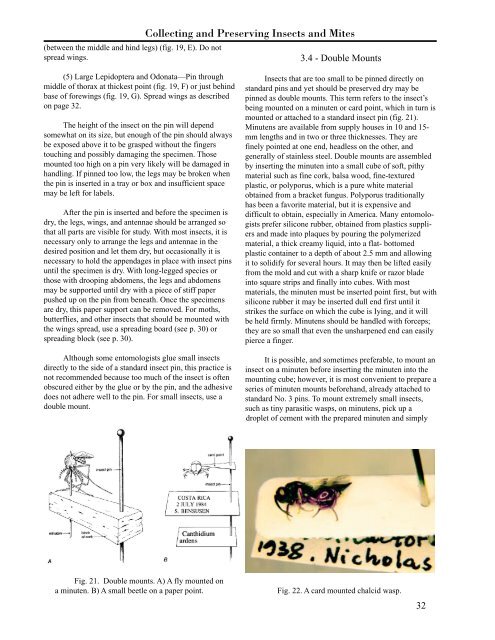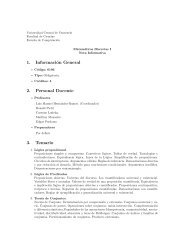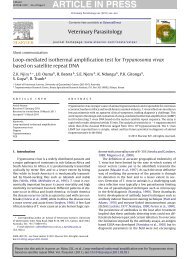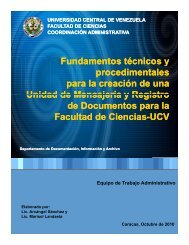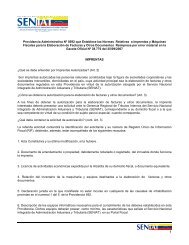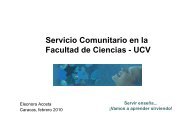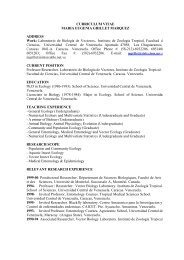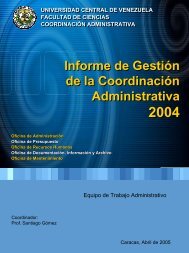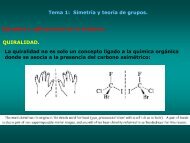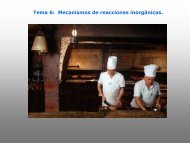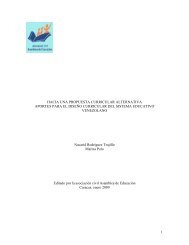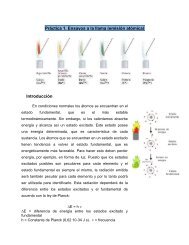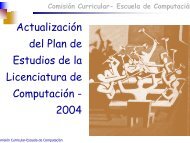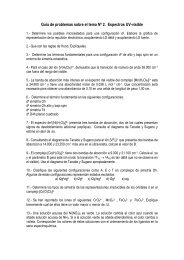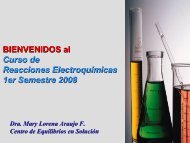Collecting and Preserving
Collecting and Preserving
Collecting and Preserving
- No tags were found...
You also want an ePaper? Increase the reach of your titles
YUMPU automatically turns print PDFs into web optimized ePapers that Google loves.
(between the middle <strong>and</strong> hind legs) (fig. 19, E). Do notspread wings.<strong>Collecting</strong> <strong>and</strong> <strong>Preserving</strong> Insects <strong>and</strong> Mites3.4 - Double Mounts(5) Large Lepidoptera <strong>and</strong> Odonata—Pin throughmiddle of thorax at thickest point (fig. 19, F) or just behindbase of forewings (fig. 19, G). Spread wings as describedon page 32.The height of the insect on the pin will dependsomewhat on its size, but enough of the pin should alwaysbe exposed above it to be grasped without the fingerstouching <strong>and</strong> possibly damaging the specimen. Thosemounted too high on a pin very likely will be damaged inh<strong>and</strong>ling. If pinned too low, the legs may be broken whenthe pin is inserted in a tray or box <strong>and</strong> insufficient spacemay be left for labels.After the pin is inserted <strong>and</strong> before the specimen isdry, the legs, wings, <strong>and</strong> antennae should be arranged sothat all parts are visible for study. With most insects, it isnecessary only to arrange the legs <strong>and</strong> antennae in thedesired position <strong>and</strong> let them dry, but occasionally it isnecessary to hold the appendages in place with insect pinsuntil the specimen is dry. With long-legged species orthose with drooping abdomens, the legs <strong>and</strong> abdomensmay be supported until dry with a piece of stiff paperpushed up on the pin from beneath. Once the specimensare dry, this paper support can be removed. For moths,butterflies, <strong>and</strong> other insects that should be mounted withthe wings spread, use a spreading board (see p. 30) orspreading block (see p. 30).Although some entomologists glue small insectsdirectly to the side of a st<strong>and</strong>ard insect pin, this practice isnot recommended because too much of the insect is oftenobscured either by the glue or by the pin, <strong>and</strong> the adhesivedoes not adhere well to the pin. For small insects, use adouble mount.Insects that are too small to be pinned directly onst<strong>and</strong>ard pins <strong>and</strong> yet should be preserved dry may bepinned as double mounts. This term refers to the insect’sbeing mounted on a minuten or card point, which in turn ismounted or attached to a st<strong>and</strong>ard insect pin (fig. 21).Minutens are available from supply houses in 10 <strong>and</strong> 15-mm lengths <strong>and</strong> in two or three thicknesses. They arefinely pointed at one end, headless on the other, <strong>and</strong>generally of stainless steel. Double mounts are assembledby inserting the minuten into a small cube of soft, pithymaterial such as fine cork, balsa wood, fine-texturedplastic, or polyporus, which is a pure white materialobtained from a bracket fungus. Polyporus traditionallyhas been a favorite material, but it is expensive <strong>and</strong>difficult to obtain, especially in America. Many entomologistsprefer silicone rubber, obtained from plastics suppliers<strong>and</strong> made into plaques by pouring the polymerizedmaterial, a thick creamy liquid, into a flat- bottomedplastic container to a depth of about 2.5 mm <strong>and</strong> allowingit to solidify for several hours. It may then be lifted easilyfrom the mold <strong>and</strong> cut with a sharp knife or razor bladeinto square strips <strong>and</strong> finally into cubes. With mostmaterials, the minuten must be inserted point first, but withsilicone rubber it may be inserted dull end first until itstrikes the surface on which the cube is Iying, <strong>and</strong> it willbe held firmly. Minutens should be h<strong>and</strong>led with forceps;they are so small that even the unsharpened end can easilypierce a finger.It is possible, <strong>and</strong> sometimes preferable, to mount aninsect on a minuten before inserting the minuten into themounting cube; however, it is most convenient to prepare aseries of minuten mounts beforeh<strong>and</strong>, already attached tost<strong>and</strong>ard No. 3 pins. To mount extremely small insects,such as tiny parasitic wasps, on minutens, pick up adroplet of cement with the prepared minuten <strong>and</strong> simplyFig. 21. Double mounts. A) A fly mounted ona minuten. B) A small beetle on a paper point.Fig. 22. A card mounted chalcid wasp.32


